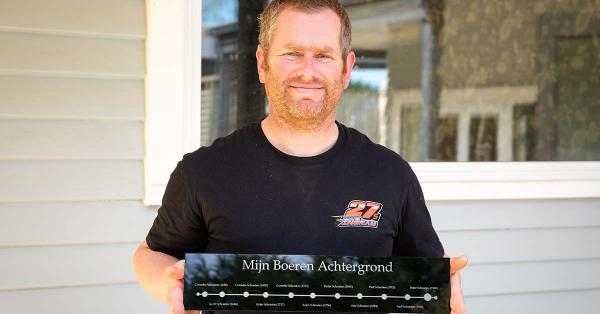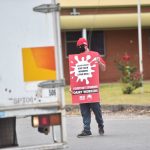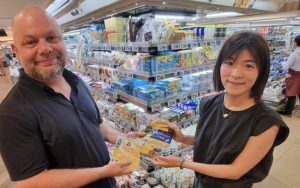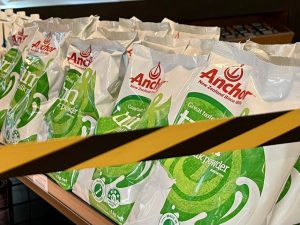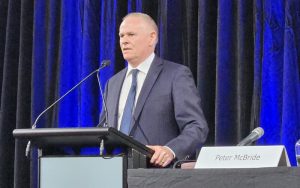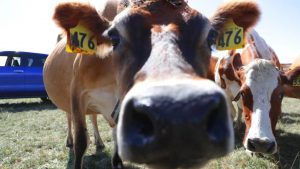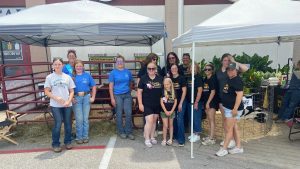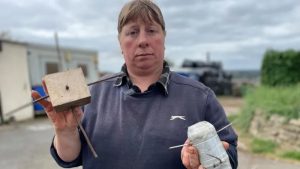
Canterbury dairy farmer Peter Schouten to maximise production at the same time as minimising his environmental footprint.
Schouten milks about 2200 cows on the two farms near West Eyreton, North Canterbury, relying on irrigation to grow pasture and crop to feed them.
“We were a little bit ahead of the game installing moisture metering because we saw some potential benefits in having that for ourselves.” he says.
“We have 16 individual moisture metering sites on our dairy platform and that gives us quite an accurate idea of all the different soil types’ moisture levels versus, I guess, the minimum specs required under the regulations.”
Born in Holland, Schouten came to New Zealand with his family 20 years ago, after his parents decided there was a better farming future for them on this side of the world.
“Me and my brother were actively helping mum and dad on the farm (in Holland) from the day we could walk basically, and that grew into pursuing it as our future career,” he says.
“When we were 15 and 16, our parents sat us down with the big question, ‘How committed are you to becoming dairy farmers?’ We answered, ‘It’s 100% what we want to do’.”
But on their 91ha farm, milking at most 135 cows, their parents knew that would be hard to achieve without making some radical changes.
“We were quite landlocked where we were and for us to grow we would have to move within Holland and that seemed like a step sideways rather than forward so they made the call to start looking outside the borders and they looked in Germany and France, they were talking about Canada, Argentina was mentioned, and so was New Zealand,” Schouten recalls.
His parents wanted to visit a close friend who was sharemilking in NZ, so they came out for a look and after that visit they were certain they wanted to come here, but it took another half dozen trips before they found a farm to buy.
“They decided fairly early it had to be Canterbury and I don’t know how many properties they looked at, but I think they’d just about had a gutsful and were about to pull the pin when a real estate agent came up with this property on South Eyre Road that we are still farming as a family now,” he says.
The 500ha farm was bigger than they really wanted and was still running merinos with some beef and cropping and had limited irrigation, but his parents bought 430ha and leased the remaining 70ha and set about having the farm converted.
“Our family friend acted as our conversion manager and, alongside him, we had some absolutely fantastic people who were key to the evolvement of our farm in the first couple of years – farm advisors, bank managers, accountants, we managed to get the right people in – and looking back now, they were absolutely key to our success at the time,” he says.
Later, they bought the remaining 70ha plus some more land, including a lifestyle block, bringing the total to 685ha. Eleven years after that, the two sons bought their parents out and then split the farm, which by now supported two sheds, between them.
“The land was laid out in such a way that there was an easy line to be drawn halfway through the farm, so basically we bought one dairy farm each and for the first couple of years we just went as hard as we could, trying to get the most out of those farms,” he says.
“I was just 29 years old, I had to go in pretty deep to buy my parents out so, yeah, we were pretty committed at the time.”
In his first two years in charge, Schouten increased production by 40%. There was still some degree of intensification possible at the time.
“When we bought the farm I think there were only 1100 cows milked, so we boosted numbers at the time and got a little bit more production per cow as well, just trying to dot the i’s and cross the t’s where we could.”
Five years ago, Schouten and wife Kristy bought another nearby farm, which they converted a year later and this season they’re milking a total of 2200 cows (1350 on their first farm and 800 on the other). That’s about 200 more cows than Schouten wants but he was caught out, mostly by the effects of covid-19 on agriculture.
He wanted to send cull cows away in February, but priority was being given to North Island stock because of drought and in March, when the lockdown came in, he couldn’t get cows into the works.
With an extra 200 mouths eating their way through his feed reserves, Schouten looked for a way to make the best of the situation.
“Just to sit on these cows and then have nothing at the other end of it – and prices were terrible at the time – we decided to put those empty cows back through a mating season,” he says.
“By the time the market started to open, we were committed – we had all these cows that had got back in calf – to see it through.”
Those cows will calve in February, but that’s not as disruptive as it may be for other farmers because he already has a split calving to fit in with his winter milking contract.
With two farms, two runoffs, nearly 2000 cows at the time and a team of fifteen staff, the pressure started to weigh on him and three years ago he took on two contract milkers to run the dairy farms and he’s very happy with the “two fantastic teams” now in place.
He’s still closely involved with the dairy platforms and manages the runoffs – and he’s still very fond of his cows.
“I’m probably the world’s worst farmer when it comes to cull cows,” he says.
“Historically my staff would have told you to avoid me that day because I’d be as grumpy as all hell when cows have to go to the works.
“Some of them are your pet cows, some of them are your top breeding cows, and it always seems to be your best cows that for some reason have to go.
“I don’t do too well under that sort of stuff, but that’s alright. I guess it’s also because of that that I’m in the dairy industry. It was my passion for cows that made me want to make this my career.”
Back in Holland, farming on heavy soil, with a short growing season and usually reliable rainfall, irrigation wasn’t needed but since coming to Canterbury, he has had to rely on irrigation to keep pastures growing even as the region sizzles in the hot, dry summers.
He gets some irrigation water from the Waimakariri irrigation scheme, but that’s often unreliable because if the Waimakariri River is too low, or in flood, the supply is shut off. For that reason, he has reliable supplies from bores on the two dairy farms. About 85% of the original farm’s irrigation needs to come from bores and 100% on the new farm.
The leased runoffs are supplied by the irrigation scheme and when supplies from that dwindled last summer, he was caught with 400 Friesian bulls he’d decided to keep because he was unhappy with calf prices being offered.
“I thought I had plenty of feed at the runoff and the bulls were meant to go to the North Island at 200kg in February/March. That never eventuated and we didn’t grow any grass, so a double whammy there,” he says.
“I guess the way around that is to make sure you have enough of a feed buffer or summer crops in the ground, but I didn’t have that leading into this problem. Anyway, that bit me in the backside a little bit – but we’re past that now.
“I had to buy a lot of feed this winter that I didn’t really want to.”
On the dairy farms, that problem’s unlikely to arise because the supply is reliable and Schouten makes sure he makes the most of the irrigation water, mostly using centre pivots, backed up with 16 separate moisture meters, up to four of them under each of the large pivots and one or two beneath the smaller ones.
“I think your soil types could be so variable throughout the property, just to have one probe in one spot, I would find it really dangerous to put all my money on that one giving me the full picture of what the farm’s doing,” he says.
“Where we don’t have soil probes, where we have a crop paddock for instance, let’s say the probe is in a pasture paddock alongside it and you have a crop paddock that has very different moisture requirements through the different stages of growth, I can’t use that moisture data for the crop without some level of scrutiny.”
In the corners where the centre pivots don’t reach, Schouten has had fixed grid irrigation installed, which can be controlled via smartphone or laptop. He says the system is growing as much grass beneath it as the centre pivots – a huge improvement on the long-line lateral system he used to have, which involved regular shifting of guns hooked into a central hydrant.
“That was almost a game of chase the brown spots and we’ve definitely improved on that and we’re definitely not using any more water, but we’re growing a lot more grass,” he says.
The posts, each topped with a sprinkler, are laid out in straight lines and spaced to allow for efficient mowing, rolling, cultivation or spraying.
The contract milkers have access to all the moisture meter data on their computer screens and it’s up to them to make decisions on when to irrigate.
They know my expectations around efficient water usage and the band of soil moisture I want to work towards,” he says.
“In its simplest form, it’s a green band drawn on a picture and they’ve got to stay within it, it’s really quite easy to follow.
“We’re trying to use technology to our advantage, but I still go out with the spade every now and then and dig a hole and have a look at the soil.
“Some of the old technology, like a spade comes in handy and I think it should be valued and not underestimated.”
Schouten says he takes the Farm Environment Plans in place for the two dairy farms and the two runoffs very seriously and expects to get top grades for recently completed environmental audits
“We do try quite hard to do right by those plans and they’re well laid out,” he says. “Consultant Dave Ashby helped us with that and they are really quite comprehensive. I think we’re tracking pretty well with those.”
The farms are high-input, high-production operations, with total production last season of 1.18 million kilograms of milksolids from 2050 cows, 719,000kg MS on the South Eyre Road property and 468,000kg MS on the Two Chain Road farm.
This season they’re budgeting for 1.2 million kg MS and so far they’re comfortably tracking ahead of that target.
“To be honest, I still believe that last year we missed the mark. I was new to feeding fodder beet and got the diet wrong,” he says.
“In hindsight, last autumn we were pushing the envelope a bit with rumen health and with that we probably lost a little bit of production towards the tail-end of the season.”
He says he didn’t feed enough fibre with the high digestible fodder beet, which led to some subacute rumen acidosis that affected both production and body condition late in the season. This season, he’s reduced the amount of fodder beet sown to 17ha from 56ha last year and that will all be lifted, cleaned and chipped and then fed to milking cows, not dry cows.
He doesn’t like feeding fodder beet in the paddock because of the mud that creates.
“As a farmer, I seriously dislike seeing cows in mud and then you go to a crop like fodder beet, well, it’s almost impossible to get away from cows in mud,” he says.
“With the high-yielding fodder beet, you give them such a small area per day compared to other crops and you only need a couple of millimetres of rain and you’re going to have a muddy mess.
“I don’t like to see cows eating something in the mud, standing in the mud, lying down in the mud.”
Most wintering is done on kale where the breaks are bigger and mud is less of an issue and young stock is generally kept on pasture.
“Depending on the winter and the weather, if I can get the crop in early enough, the yearlings might get an offering of forage rape mid-winter and a bit of baleage on the side. The rest of the silage all goes to the milking platforms and that will be done in the form of barley whole-crop, maize silage, fodder beet as lifted beet and pasture silage,” he says.
Spring calving is slightly later than most of his neighbours, with heifers in the first week of August and the cows four to five days later.
“Because we’re already milking cows through winter, we’re already putting pressure on that pasture cover, so we don’t really want to have them calving any earlier because it’s too early,” he says.
“You’re just going to end up feeding out more silage as the pasture demand and pasture growth curves won’t pair up nicely.”
The cows wear AllFlex collars for heat detection and now all mating is done with AI, with no bulls being used except with the yearling heifers.
“The last day of AI is planned to be December 23. I didn’t really fancy the idea of the boys doing stuff like AI on Christmas Eve,” he says.
“With that date, we should be finished calving before the end of September and that means there is a good clear month between the last cow calving and having to worry about AI, which means a lot of the other stuff on-farm can get ticked off.
“If you’re still calving in November and you’re starting to mate in late October, everything overlaps and you’re busy the whole time and all the little jobs are forgotten about.”
One of the reasons Schouten has split calving and winter milking is because he hates the idea of high-producing cows being culled because they didn’t get in calf. He prefers to give them a second chance.
“If they miss that second time, yes they will go but most of them actually get in calf that second mating. We only have a really short mating in autumn – I think last year it was six weeks,” he says.
The second calving is at the end of the first week in February and over by the end of March. Calves are weaned at 120kg.
It’s a complex operation and technology plays an important part in keeping the farms running efficiently and profitably, but Schouten says old-fashioned farming instinct is just as important.
“A farmer’s on-the-ground common sense on the day goes a long way in my books. I’ve farmed here for 20 years, but I’ve farmed all my life,” he says.
In fact, Schouten’s farming heritage goes back hundreds of years and for his 40th birthday recently, his family gave him a plaque that tracked his forbears back to 1620, all of whom were dairy farmers. It’s titled Mijn Boeren Achterground, which translates to My Farming Background.
“This doesn’t include my son. I’m hopeful he will consider it as a career and it doesn’t show any generations leading up to it, which I believe more likely than not were dairy farming as well,” he says
“This is 400 years, this is pretty bloody cool if you ask me. I’m really proud of this. It shows the depth of involvement we’ve had in the agriculture industry and I have no desire to stop that.”
He says it’s that heritage which makes him determined to look after it to protect it for future generations.
Farm facts
Owners: Peter and Kristy Schouten
Location: West Eyreton, North Canterbury
Farm size: Eyrewell 382ha (360ha eff), Waipapa 191.5ha (180ha eff), lease 540ha
Cows: 2000 Friesian
Production: 2019-20, 1.18 million kg MS
Production target: 2020-21, 1.2 million kg MS
